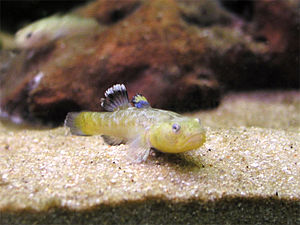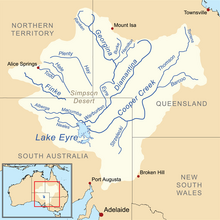Chlamydogobius
| Chlamydogobius | ||||||||||||
|---|---|---|---|---|---|---|---|---|---|---|---|---|

Australian goby ( Chlamydogobius eremius ) |
||||||||||||
| Systematics | ||||||||||||
|
||||||||||||
| Scientific name | ||||||||||||
| Chlamydogobius | ||||||||||||
| Whitley , 1930 |
Chlamydogobius (Gr. Chlamys , genitive Chlamydos = coat) or desert gobies are a genus of small freshwater fish from the family Oxudercidae within the goby-like (Gobiiformes), which isendemicto Australia .
features
Desert gobies have the typical elongated, rotating goby shape, a beefy head and a large mouth. Their basic color is grayish, often with a coarse, reticulated pattern. The first dorsal fin is brightly colored, often blue, yellow or white in the upper third and smaller than the second dorsal fin, which is gray-blue or transparent. The desert gobies are five to six inches long. They have no swim bladder and use their pectoral fins to support themselves on the ground.
Occurrence
The desert gobies are found locally in the interior of Australia - except for Chlamydogobius ranunculus , the shallow, muddy, low- salinity waters near the coast in Queensland and the Northern Territory . The occurrences of Chlamydogobius squamigenus and Chlamydogobius micropterus in Queensland are particularly endangered due to their limited range. The habitats fed by Artesian springs are threatened by grazing animals and the abstraction of groundwater. Exotic gambus ( Gambusia holbrooki ) may contribute to the endangerment.
Way of life
In their arid habitats, desert gobies have to cope with large seasonal changes in water quality and high day-night fluctuations. The temperatures of the waters can fluctuate between 3 and 43 ° C and the salinity of pure fresh water can briefly reach up to 6%. They have already been found in waters with an extremely low oxygen content (0.8 ppm dissolved oxygen), and the oxygen concentration is often below 5 ppm. Under these conditions they emerge and "swallow" air. At the same time, they use the effect of evaporative cooling. It was also observed that they are on algae which photosynthesis stop run, presumably to accommodate the produced oxygen.
In these habitats they usually stay under stones and water plants, where they are protected from predators and the extreme temperatures. You can adapt their body color to the surroundings. Desert gobies eat everything, mainly algae, zooplankton , small aquatic insects, fish eggs and detritus . Spawning time in the natural habitat is between November and March, up to 300 eggs are laid under stones or other hard objects. The males guard the clutch and continuously fanned out fresh water until the larvae hatch after 10-17 days. Newly hatched larvae are approximately 5 mm long. They eat zooplankton and reach a size of 4 to 5 cm after half a year.
Systematics
Six species are grouped together in the genus Chlamydogobius :
- Australian desert goby ( Chlamydogobius eremius ) (Zietz , 1896) - Occurrence: south-west of Lake Eyre in South Australia
- Chlamydogobius gloveri Larson , 1995 - Occurrence: Dalhousie Springs in northern South Australia
- Chlamydogobius japalpa Larson , 1995 - Occurrence: Water holes in the area of the Finke River in the south of the Northern Territory
- Chlamydogobius micropterus Larson , 1995 - Occurrence: some springs at Springvale Station , 80 km southeast of Boulia in western Queensland
- Pygmy desert goby ( Chlamydogobius ranunculus ) Larson , 1995 - Occurrence: widespread near the coast in northern Queensland and the Northern Territory
- Chlamydogobius squamigenus Larson , 1995 - Occurrence: some springs in central Queensland on the Edgbaston Reservation near Aramac, Barcaldine Region , in the Thomson River basin
swell
- Helen K. Larson : A Review of the Australian endemic gobiid genus Chlamydogobius, with description of five new species . In: The Beagle Records of the Northern Territory Museum of the Arts and Sciences . tape 12 , 1995, p. 19-51 .
- G. Allen, S. Midgley, M. Allen: Field Guide to the Freshwater Fishes of Australia . 2nd Edition. Western Australian Museum, Perth 2003, ISBN 0-7307-5486-3 .

